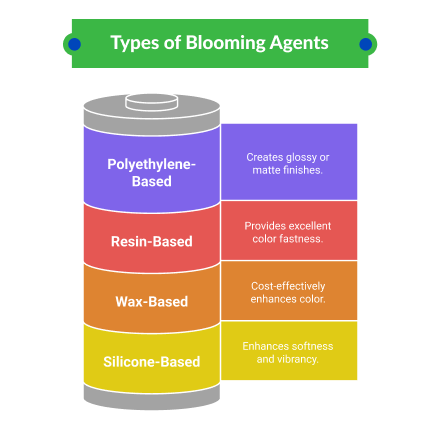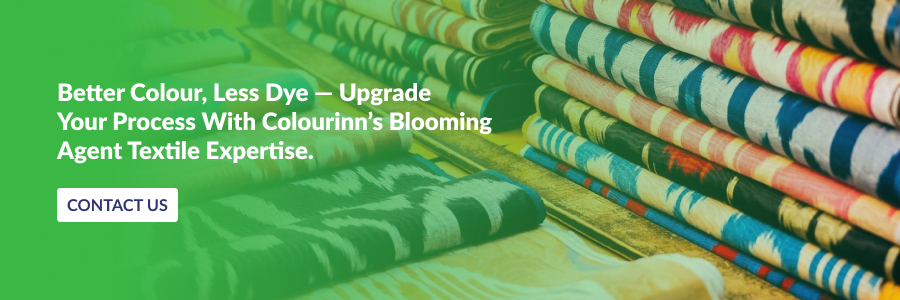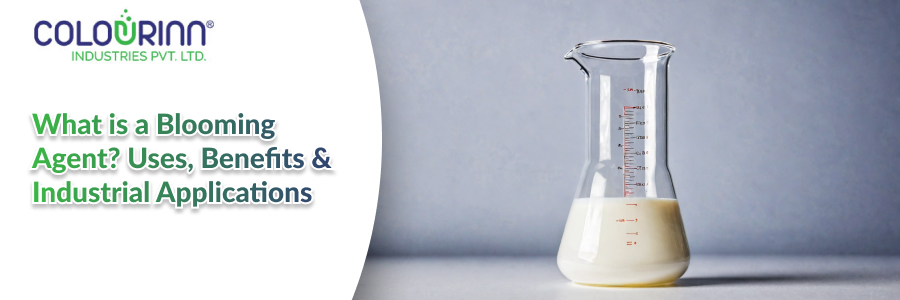A blooming agent is a game-changer in textile processing, making colours deeper and fabrics more vibrant.
This guide explains what blooming agents are, how they work and their uses in textiles, from polyester to cotton. We’ll cover benefits like cost-efficiency and sustainability, industrial applications and how Colourinn Auxiliaries is a blooming agent textile pioneer.
Discover how these agents create richer, longer-lasting fabrics that meet modern industry demands.
What is a Blooming Agent?
A blooming agent is a textile processing auxiliary that increases dye uptake, resulting in deeper, more vibrant colours. By increasing the fabric’s refractive index, these chemicals make more light is absorbed, creating richer hues.
Used in blooming agent textile applications, they work on polyester, cotton and blends, aesthetics and functionality.
How Blooming Agents Work
The magic of a blooming agent is in its chemistry. It interacts with fabric fibers through cross-linking and polymerisation, forming a strong bond that enhances dye penetration. This results in:
- Deeper Colour: Fabrics look darker and more vivid.
- Special Effects: Some agents create pearlescent or fluorescent finishes.
For example, silicone-based blooming agents give a soft feel, while resin-based ones improve durability.
Types of Blooming Agent
Not all blooming agents are the same. Different types are for specific fabrics and effects in the textile processes. Here’s a breakdown:

Silicone-Based Agents
These agents give a soft hand feel and vibrant colors, popular for polyester and blends. Eco-friendly and versatile.
Wax-Based Agents
Wax-based blooming agents are cost-effective colour enhancers but lack durability compared to others.
Resin-Based Agents
Resin-based agents excel in colour fastness, colours don’t fade from washing or sunlight exposure.
Polyethylene-Based Agents
These are for specific finishes, like glossy or matte effects and are used in technical textiles.
| Type | Pros | Cons | Best for |
| Silicone-Based | Soft feel, eco-friendly | Higher cost | Polyester, blends |
| Wax-Based | Affordable | Less durable | Casual fabrics |
| Resin-Based | High colour fastness | Stiffer feel | Durable textiles |
| Polyethylene-Based | Unique finishes | Limited applications | Technical textiles |
Applications in Textiles
Blooming agents are the stars of textile processes, working on fabrics across industries. Their main applications are:
- Dyeing: Increases dye uptake for deeper colours.
- Printing: Improves colour definition in prints.
- Finishing: Adds special effects like gloss or fluorescence.
- Speciality Textiles: Used in sportswear, workwear and home furnishings for aesthetics and functionality.
For example, a blooming agent can make a polyester jacket’s colours pop and withstand multiple washes.
Also, visit our Textile Finishing Chemicals solutions for eco-friendly and sustainable fabric enhancement.
Benefits You Need to Know
Why choose a blooming agent for textile processing? The benefits are many, which is why manufacturers choose them.

- Better Colour: Blooming agents give deeper, more uniform colours, with less dye. Fabrics meet consumer expectations for colour.
- Durability: They improve colour fastness, so fabrics resist fading from sun, wash or wear, and extend product life.
- Versatility: From cotton to synthetic blends, blooming agent textile solutions work on all fabrics for all manufacturers.
- Sustainability: Eco-friendly options like silicone-based blooming agents reduce environmental impact, in line with global sustainability goals.
Industrial Applications
Blooming agents are used in many industries beyond textiles.
- Fashion and Apparel: Colour deepening agent textile solutions are key in fashion, where colour and softness matter. Think bright dresses or durable denim.
- Home Textiles: Curtains, upholstery and bedding benefit from these agents, which add colour and durability for daily use.
- Technical Textiles: In automotive and medical industries, blooming agents improve the aesthetics and functionality of fabrics used in car interiors or surgical gowns.
- Speciality Products: From sportswear to outdoor gear, blooming agents ensure fabrics are both beautiful and performance-ready.
How to Choose the Right Blooming Agent
Choosing the right colour deepening agent depends on your fabric and goals. Consider these:
- Fabric Type: Cotton needs a different agent than polyester.
- Desired Finish: Glossy, matte or fluorescent? Choose accordingly.
- Application Method: Padding or spraying affects agent choice.
- Environmental Impact: Opt for eco-friendly options when possible.
For example, Colourinn’s silicone-based blooming agents are perfect for polyester, for vibrant colours and a soft feel.
Techniques for Applying Blooming Agent
Applying the colour deepening agent requires precision for best results. Methods include:
- Padding: Soaking fabric in a blooming agent solution for uniform coverage.
- Spraying: Targeted application for specific effects.
- Exhaust Method: Used in dyeing baths for deep penetration.
Make sure fabrics are clean and pH 4-5 during application for maximum effectiveness.

Challenges and Solutions
Blooming agents are powerful but come with challenges:
- Compatibility: Some agents may not work on all fabrics. Solution: Test beforehand.
- Cost: High quality agents can be expensive. Solution: Balance cost with long term savings from reduced dye use.
- Environmental Impact: Some agents can harm the environment. Solution: Choose eco-friendly options like Colourinn’s silicone-based agents.
Future Textile Trends
The future of blooming textile solutions looks bright:
- Bio-Based Agents: From natural sources for sustainability.
- Smart Textiles: Blooming agents that add functionality like UV resistance.
- Automation: Improved application methods for precision and speed.
These trends will make these agents even more essential to textile manufacturing.
Why Colourinn is the Blooming Agent Expert
At Colourinn Auxiliaries, we master blooming agent technology to change textiles. This guide has shown how these agents increase colour depth, reduce costs and support sustainability in industries like fashion and technical textiles. We deliver vibrant, durable fabrics that meet your needs.
Ready to bring your textiles to life with top-quality blooming textile solutions? Contact Colourinn to learn more about our products. How can we help you with your textile production? Let’s create beautiful fabrics together!
Frequently Asked Questions(FAQs):
Q1. What are Blooming Agents in the textile industry?
A. Blooming Agents in the textile industry are chemical additives used to enhance fabric surface properties, such as softness, finish, and overall appearance.
Q2. What are the main uses of Blooming Agents in textiles?
A. Blooming agents are used in the textile industry mainly for enhancing surface finish, softness, ensuring uniform application of dyestuffs, coatings, etc.
Q3. Are Blooming Agents safe for use in the textile industry?
A. Yes, most Blooming Agents used in the textile industry are safe and compliant with industry standards, ensuring both product quality and environmental safety.

